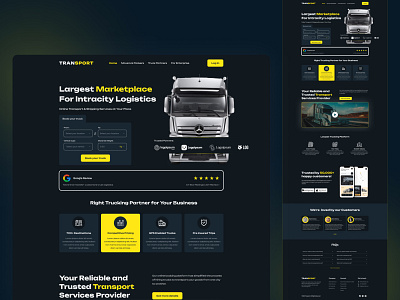Exactly How Specialized Transport Website Design Assists Improve Client Engagement and Conversion
By focusing on user-centric functions, these internet sites not just improve navigating but additionally adjust effortlessly to numerous devices, making sure accessibility for all users. The strategic assimilation of visual elements and clear call-to-action motivates can substantially affect user habits.
Relevance of User-Centric Design
In today's electronic landscape, a user-centric style is critical for specialized transport internet systems - transportation web design. This approach focuses on the needs and preferences of users, boosting their overall experience while browsing intricate transport services. By concentrating on use, availability, and user-friendly navigating, companies can promote a feeling of trust fund and reliability amongst customers, which is essential in the transportation industry
User-centric style entails complete study to comprehend the target market's habits, motivations, and obstacles. This expertise notifies the development of functions such as structured reservation processes, simple accessibility to service details, and receptive consumer support. Customization can be incorporated to cater to specific customer choices, leading to enhanced involvement and fulfillment.
Executing a user-centric style not only enhances the capability of transport web systems yet additionally boosts conversion rates. When users find a system very easy to navigate and receptive to their demands, they are much more most likely to total purchases and return for future services. Inevitably, a well-executed user-centric layout adds to the general success of specialized transport services by enhancing customer loyalty and motivating repeat business.
Impact of Visual Components
While the functionality of a specialized transport web system is crucial, the effect of aesthetic aspects can not be forgotten. A well-designed aesthetic format plays an essential function in capturing individual focus and assisting in info retention. Reliable use shade, typography, and images not only enhances the aesthetic allure yet likewise communicates brand name identification and professionalism and trust.
Aesthetic elements, such as high-quality images of transport solutions, can stimulate count on and credibility, encouraging potential clients to involve even more. Infographics and icons streamline intricate information, making it a lot more digestible. This clearness can lead to lowered bounce rates and raised time spent on site, both of which are favorable signs of user interaction.
In addition, a regular visual pecking order overviews individuals via the site effortlessly, making certain that important details-- such as service offerings, rates, and call details-- is easily obtainable. This calculated setup assists to direct potential clients towards desired actions, such as filling in a get in touch with type or asking for a quote.

Mobile Responsiveness Advantages
The value of visual aspects encompasses mobile responsiveness, which is significantly important in today's digital landscape. As more customers accessibility websites via mobile phones, a receptive design makes sure that web content is shown ideally throughout various screen sizes. This versatility not only improves customer experience but additionally significantly impacts client involvement and conversion rates.
Mobile responsiveness allows specialized transport firms to meet the assumptions of a diverse clients. Users are more probable to remain on a site that is easy to browse on their smartphones or tablet computers, resulting in longer session durations and lowered bounce prices. A mobile-friendly design builds trustworthiness; customers are much more likely to trust and engage with a company that presents itself well on all gadgets.
In addition, search engines like Google focus on mobile-optimized web sites in their ranking algorithms. transportation web design. Subsequently, companies that purchase mobile responsiveness can improve their exposure and attract even more organic web traffic. This enhanced exposure can translate into greater conversion prices, as potential customers are more likely to speak to or publication services with a site that works flawlessly on their smart phones. Thus, mobile responsiveness is a necessary part of efficient internet design in the specialized transport sector.
Streamlining Navigation Experience

A well-structured navigation experience is crucial for specialized transport sites, as it straight affects customer engagement and satisfaction. When prospective clients see these websites, they expect to locate info quickly and efficiently. A streamlined navigating system can dramatically boost this procedure, leading users flawlessly with different solutions, rates options, and call details.
To attain optimal navigation, it is important to classify content rationally. Making use of a clear hierarchy-- such as main and secondary menus-- aids customers discern where to discover certain details without feeling bewildered. Furthermore, including drop-down menus can provide fast blog access to subcategories, lessening click depth, which is vital for retaining individual attention.
Moreover, a search function allows customers to bypass navigating altogether, satisfying those investigate this site who understand precisely what they seek. Executing breadcrumb routes can additionally boost the customer experience by providing an aesthetic pathway back to previous web pages, reinforcing website framework.
Incorporating mobile-friendly navigation is just as vital, as several users gain access to specialized transport sites on their smartphones. By prioritizing an intuitive and receptive design, companies can make sure that their internet site successfully offers diverse customer demands, inevitably improving client interaction and conversion rates.
Incorporating Call-to-Action Methods
Effective call-to-action (CTA) strategies are crucial for assisting users toward desired end results on specialized transportation web sites. These approaches not just enhance customer engagement however additionally dramatically enhance conversion prices. CTAs should be strategically positioned throughout the site, ensuring they are conveniently noticeable and obtainable.

Incorporating seriousness in CTAs, such as limited-time deals or unique offers, can additionally encourage individuals to act promptly. A/B screening different CTA designs and positionings can offer beneficial insights into what resonates ideal with the target audience.
Furthermore, ensuring that CTAs are mobile-friendly is paramount, as a substantial section of users may access the website through mobile phones. transportation web design. By thoughtfully integrating these approaches, specialized transport websites can click this site effectively guide users with the conversion funnel, ultimately resulting in boosted customer involvement and successful outcomes
Verdict
In final thought, specialized transportation web style significantly enhances client engagement and conversion by prioritizing user-centric attributes, integrating impactful visual components, and making sure mobile responsiveness. Structured navigating experiences and well-integrated call-to-action methods better contribute to a seamless customer journey.